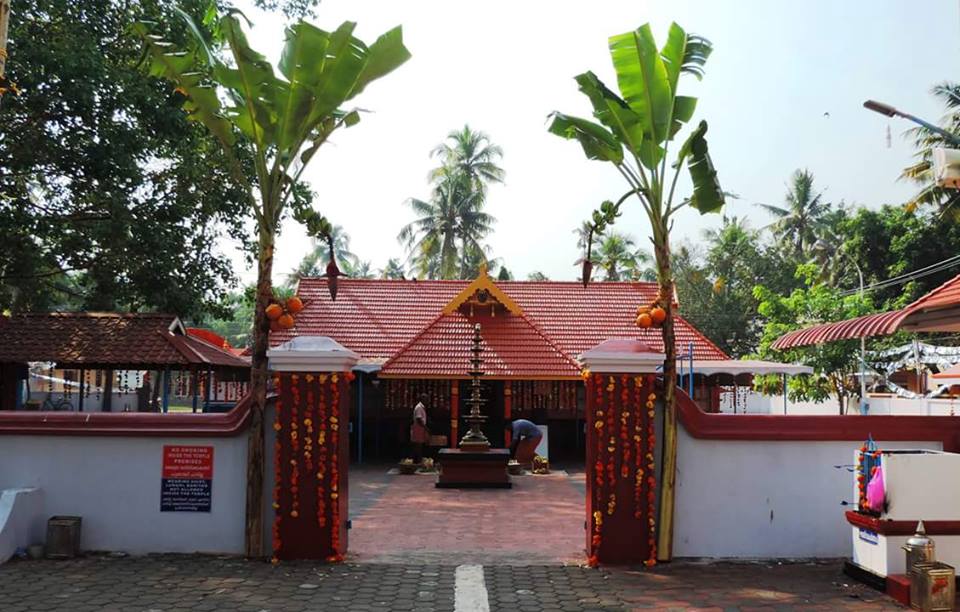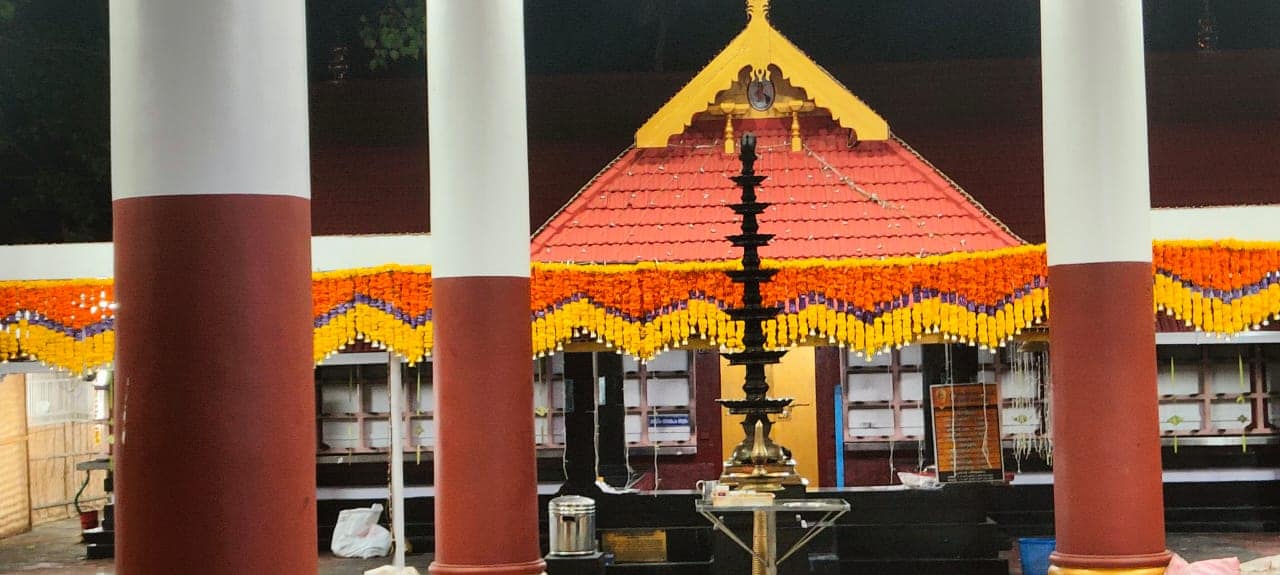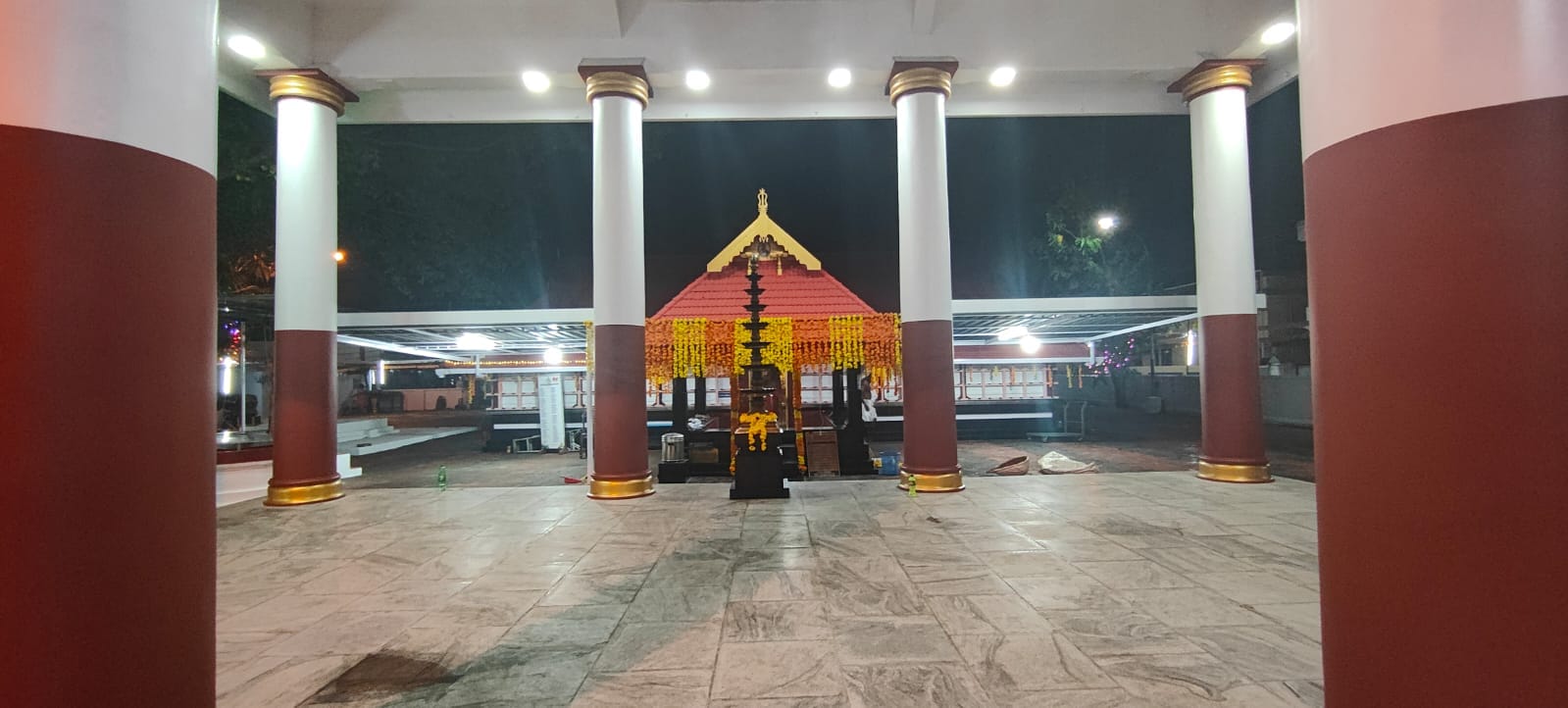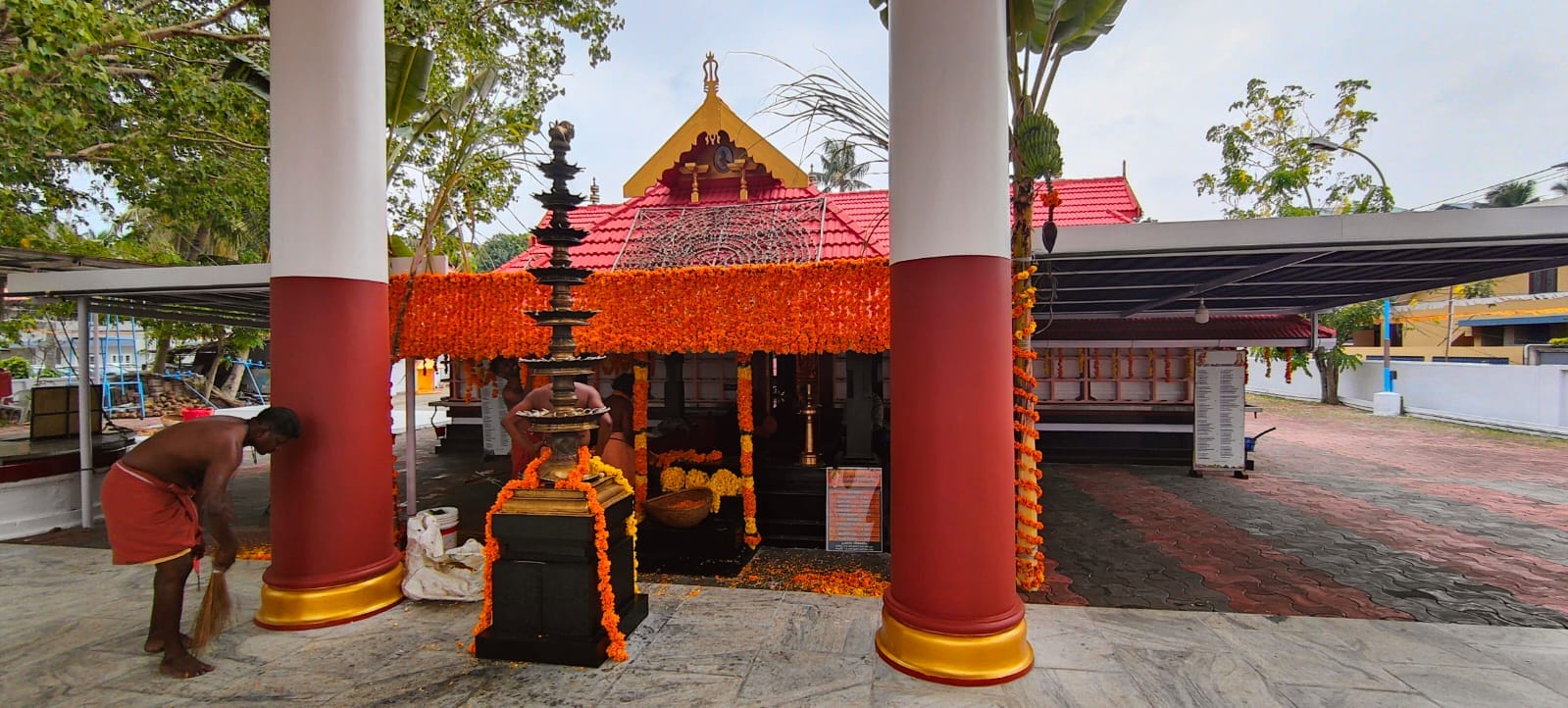Ponnethkavu Bhagavathy Temple, located in Kadavanthra, Ernakulam, has a rich history dating back approximately 800 years.

Originally, the temple and its vast 2000-acre land were owned by the prestigious Thamarassery Mana. However, due to inter-family marriages through the "Pudava" system, the ownership gradually transferred to other families, leading to the decline of Thamarassery Mana. Over time, the misuse of Brahmin property led to numerous misfortunes, including family divisions, diseases, and conflicts.Years later, a descendant of the Thamarassery Mana, a deeply spiritual Brahmin and devotee of Kodungallur Amma, returned in search of his ancestral roots. Carrying only holy books and an umbrella, he visited the ancient temple-related families, urging them to perform atonement rituals for the past transgressions of his ancestors.
However, his pleas were ignored. Disheartened, he arrived at the Dharma Devatha Kshethra Thara (later known as Ayyankandazath Kshethra, now Kadavanthara Devi Temple) and sincerely prayed for divine forgiveness. During his prayers, he placed his belongings, including his umbrella, at the temple pond and took a ritual bath. Suddenly, a strong wind and rainstorm swept through, causing his items to drift towards the present location of the Ponneth Temple. Following them, he witnessed a divine aura around his umbrella. The Goddess appeared before him, forgiving his forefathers' sins and instructing him to remain in Kadavanthra, as her divine presence would forever reside there.
She commanded him to restore his ancestral lands and guide the people. Honoring this divine decree, he built the Ponneth Temple at the exact location where the umbrella had come to rest, which is why the temple faces north.It is believed that Devi occasionally visits the places that once belonged to her and rests at the Peedha of Kadavanthara Devi Temple. To commemorate this, the first "Thalam" light during the temple festival is ignited from Kadavanthara Devi Temple. Over time, the temple's lands were lost, and the temple itself was eventually destroyed by fire. In 1096 ME (Malayalam Era), a Madras Court declaration transferred the temple and its property to non-Hindus.
However, in 1099 ME, control of the temple was restored to Shri Damodaran Unni of Ponneth Madom, whose descendants continue to manage the temple today. The temple was reopened for monthly pujas in the Malayalam month of Vrischikam. By 1124 ME, regular pujas, festivals, and temple activities resumed, continuing uninterrupted to this day.
Between 1024 and 1159 ME, the temple was managed by Kadavanthara N.S.S, followed by the Cheruparambath family, and later by the local Kshetra Samiti from 1160 to 1165 ME. Since 1166 ME, the present Ponneth family, with the support of the local community, has maintained the temple and its activities. The sacred Brahmin of Thamarassery Mana, who played a pivotal role in the temple's restoration, is honored as Brahmarakshas, and daily poojas are performed in his name.
Even today, people of all castes seek the blessings of the Brahmarakshas before beginning any construction near the temple. The special pooja dedicated to him is Palpayasam. A remarkable event occurred at the temple pond when multiple lotus flowers bloomed from a single stem—a rare and miraculous sight. During an Ashtamangalya Prasnam (astrological consultation), it was revealed that this phenomenon, known as "Erratta Thamara" (Double Lotus), signifies the divine presence of Goddess Lakshmi within the temple. Devotees from far and wide visit the temple to witness this extraordinary occurrence.
The temple houses several deities, including Bala Bhathra, Lord Shiva with Parvati, Lord Ganesha, Dharma Shastha, Brahma Rakshas, Nagaraja, Nagayakshi, Vellaam Bhagavathy (Para Devatha), and Ghandakarnan.
Annual Thalapoli Mahotsavam, held in the Malayalam month of Makaram (January-February), is the temple's most significant festival. The festival lasts for seven days, beginning on Avittam and concluding on Bharani. It features daily pujas, para eyunallipu, and a grand procession with a decorated temple elephant carrying the deity. On the sixth day, the Pakalpooram procession starts from Ayyankandazath Temple and reaches Ponneth Temple with para offerings along the way. The festival concludes on the seventh day with Thookam.
The significant pujas & offerings at Ponnethkavu Bhagavathy Temple include major pujas such as Udayasthamana Puja, Kalabham, Thrikalapuja, and Niramala-Chittuvilakk. Special homams and rituals performed are Mrityunjaya Homam, Mrityunjaya Pushpanjali, Chuttuvillak, and Nagapuja (Aayilyam). Devotional offerings include Vivaham, Swayamvara Puja, Choroon, Thulabharam, Adima, and Bhagyasooktta Pushpanjali, while abhishekams and sevas comprise Dhara, Neelaanjana Ayyappan, Aikyamatya, Ottayappam, and Swayamvara Pushpanjali. Festive and traditional offerings feature Bhagavathy Seva, Sahasranama Archana, Namaskaram, and Astottara Pushpanjali, while ceremonial rituals include Vidhyarambham, Atimadhura Neipayasam, Vavupuja, Neipayasam, Vahanapuja, and Shayanapradhakshinnam. The special prasadam offerings consist of Koottpayasam, Kettunirra, Piyinja Payasam, and Appam.
പൊന്നേത്ത്കാവ് ഭഗവതി ക്ഷേത്രം, കടവന്ത്ര
എറണാകുളം ജില്ലയിലെ സഹോദരൻ അയ്യപ്പൻ റോഡിൽ, കടവന്ത്ര ജംഗ്ഷനിൽ നിന്ന് ഏകദേശം ഒരു കിലോമീറ്റർ ദൂരത്താണ് ചരിത്രപ്രസിദ്ധമായ പൊന്നേത്ത്കാവ് ഭഗവതി ക്ഷേത്രം സ്ഥിതിചെയ്യുന്നത്. ഏകദേശം 800 വർഷങ്ങൾക്ക് മുമ്പ്, 2000 ഏക്കർ വിസ്തൃതിയുള്ള ഈ ക്ഷേത്രം പ്രസിദ്ധമായ താമരശ്ശേരി മനയുടെ ഉടമസ്ഥതയിലായിരുന്നു. “പുടവ” സമ്പ്രദായത്തിലൂടെ വിവിധ കുടുംബങ്ങളുമായി വിവാഹബന്ധം സ്ഥാപിച്ചതോടെ, ക്രമേണ ക്ഷേത്രത്തിന്റെ മുഴുവൻ സ്വത്തുക്കളും ഇവർക്ക് കൈമാറപ്പെട്ടു. നിയമവിരുദ്ധമായ ബന്ധങ്ങൾ, വഴിവിട്ട പ്രവൃത്തികൾ എന്നിവയിലൂടെ ക്ഷേത്രത്തിന്റെയും അതിന്റെ ആചാരപരമായ മഹത്വത്തിന്റെയും ആഘോഷം നഷ്ടപ്പെട്ടുവെന്നും, ഇതിന്റെ ഫലമായി ക്ഷേത്രം നശിച്ചുപോയെന്നുമാണ് വിശ്വാസം.
ബ്രാഹ്മണ സ്വത്തുക്കളുടെ അനധികൃത കൈവശപ്പെടുത്തൽ മൂലം ഈ കുടുംബങ്ങൾ കടുത്ത പ്രതിസന്ധിയിലാവുകയും, കുടുംബ പിളർപ്പ്, രോഗങ്ങൾ, കലഹങ്ങൾ എന്നിവ നിറഞ്ഞു വന്നതോടൊപ്പം, നിരവധി 'ശാപങ്ങൾ' അവർക്കെതിരെ പ്രവർത്തിച്ചുവെന്നും പറയപ്പെടുന്നു. ഒരിടവേളക്ക് ശേഷം, താമരശ്ശേരി മനയിലെ ഒരു ശുദ്ധാത്മാവായ നമ്പൂതിരി കുടുംബാംഗം തൻറെ പൂർവ്വികരുടെ വേരുകൾ തിരയുന്നതിനായി പഴയ മന സന്ദർശിക്കാൻ തീരുമാനിച്ചു. കൊടുങ്ങല്ലൂർ അമ്മയുടെ സമർപ്പിതനായ ആരാധകനായിരുന്ന അദ്ദേഹം ക്ഷേത്രത്തിൽ നിന്ന് ദൂരെ പോകേണ്ടി വരുന്നതിൽ ദുർഖതിലായിരുന്നു.
അതിനിടെ, ഭഗവതി അദ്ദേഹത്തിന്റെ അറിവില്ലാതെ തന്നെ അയാളുടെ കുടയിൽ (ഓലക്കുട) ആകർഷിതയായി ചേർന്നുവെന്നു കരുതപ്പെടുന്നു. ഈ ബ്രാഹ്മണൻ കൊണ്ടുപോയത് പുരാണ പുസ്തകങ്ങളും കുടയും മാത്രമായിരുന്നു. തുടർന്ന്, ക്ഷേത്രവുമായി ബന്ധപ്പെട്ട പുരാതന കുടുംബങ്ങളെ സന്ദർശിച്ച് തൻറെ ഉദ്ദേശ്യങ്ങൾ വിവരിച്ചെങ്കിലും, ക്ഷേത്രം കൈവശം വെച്ചിരുന്ന ആ കുടുംബങ്ങൾ അവഗണനയായിരുന്നു കാണിച്ചത്.
തൻറെ പൂർവ്വികർ ചെയ്ത ദോഷങ്ങൾക്ക് പരിഹാരമായി ക്ഷേത്രത്തിൽ പ്രായശ്ചിത്ത കർമ്മം നടത്തുക എന്നതാണ് ഈ യാത്രയുടെ ലക്ഷ്യം. ആഴത്തിലുള്ള നിരാശയോടെ, അദ്ദേഹം പുരാതനമായ ധർമ്മ ദേവ ക്ഷേത്രത്തിൽ എത്തി. (പിന്നീട് ഇത് 'അയ്യങ്കണ്ടത്ത് ക്ഷേത്രം' എന്നായും, കടവന്തറ ദേവി ക്ഷേത്രം എന്നും അറിയപ്പെട്ടു.) അവിടെ, അമ്മയുടെ അനുഗ്രഹം തേടി തൻറെ പൂർവ്വികർ ചെയ്ത എല്ലാ പാപങ്ങൾക്കും മുക്തി പ്രാപിക്കാനായി, ഭക്തിപൂർവ്വം പ്രാർത്ഥന ആരംഭിച്ചു.
ഒരു ദിവസം പതിവ് പ്രാർത്ഥനയ്ക്കായി അയ്യങ്കണ്ടത്ത് ക്ഷേത്രത്തിലെത്തിയ ബ്രാഹ്മണൻ, കൊടുങ്ങല്ലൂരിൽ നിന്നുള്ള കുടുംബരേഖകൾ, തുണിക്കെട്ടുകൾ, കുട, പുരാണ പുസ്തകങ്ങൾ എന്നിവ ക്ഷേത്രക്കുളത്തിന്റെ പടിയിൽ വച്ച് കുളിക്കാൻ ഇറങ്ങി. അപ്പോൾ പെട്ടെന്ന് ശക്തമായ കാറ്റും മഴയും വന്നതോടെ, അദ്ദേഹത്തിൻറെ ജംഗമസ്വത്തുക്കൾ എല്ലാം അയ്യങ്കണ്ടത്ത് ക്ഷേത്രത്തിൻറെ വലതുവശത്തേക്ക് പറന്നുപോയി. അവയെ തിരികെ നേടാൻ ബ്രാഹ്മണൻ പിന്തുടർന്നപ്പോൾ, കെട്ടുകൾ ഇപ്പോഴത്തെ പൊന്നേത്ത് ക്ഷേത്രം നിലകൊള്ളുന്ന സ്ഥലത്ത് വന്നു വീണു.
പെട്ടെന്ന്, തന്റെ കുടയ്ക്കു ചുറ്റും ഒരു ദിവ്യ പ്രഭാവലയം രൂപപ്പെട്ടതായി അദ്ദേഹം കണ്ടു. അപ്പോൾ ദേവിയുടെ അരുളിപ്പാട് ലഭിച്ചുകൊണ്ട്, തൻറെ പൂർവ്വികർ ചെയ്ത എല്ലാ പാപങ്ങളും ക്ഷമിക്കപ്പെട്ടിരിക്കുന്നു എന്നും, ഇനി കൊടുങ്ങല്ലൂരിലേക്ക് മടങ്ങരുതെന്നും ദേവി ആവശ്യപ്പെട്ടു. ദേവിയുടെ ചൈതന്യം ഈ സ്ഥലത്ത് എന്നേക്കുമായി നിലനിൽക്കും എന്നും ദേവി വാഗ്ദാനം ചെയ്തു. തൻറെ പൂർവ്വികരുടെ സ്വത്തുക്കൾ പരിപാലിക്കാനും, ജനങ്ങളെ സദ്മാർഗത്തിലേക്ക് നയിക്കാനും ദേവി ബ്രാഹ്മണനെ നിർദ്ദേശിച്ചു.
കുട കിടന്ന അതേ സ്ഥലത്ത് ബ്രാഹ്മണ പുരോഹിതൻ ഒരു ക്ഷേത്രം നിർമ്മിച്ചു, അതിനാലാണ് ഇപ്പോഴത്തെ ക്ഷേത്രം വടക്കോട്ട് അഭിമുഖമായിരിക്കുന്നതെന്ന് കരുതപ്പെടുന്നത്. ഈ ദിവ്യ സംഭവത്തിനുശേഷം ദേവി, തനിക്കൊന്നുകാലത്ത് സ്വന്തമായിരുന്ന എല്ലാ സ്ഥലങ്ങളും സന്ദർശിക്കുകയും, വർഷത്തിൽ ഒരിക്കൽ താമരശ്ശേരി മനയിലെ ധർമ്മദേവതയായിരുന്ന കടവന്തറ ദേവി ക്ഷേത്രത്തിലെ പീഠത്തിൽ വിശ്രമിക്കുകയും ചെയ്യുമെന്നു വിശ്വസിക്കപ്പെടുന്നു. ഇതിന്റെ ഓർമയ്ക്കായി, ക്ഷേത്രോത്സവകാലത്ത് ആദ്യ ‘താളം’ വിളക്ക് കടവന്ത്ര ദേവി ക്ഷേത്രത്തിൽ നിന്ന് തെളിയിക്കുന്നു.
ക്ഷേത്രപരിസരത്ത് എന്തെങ്കിലും നിർമാണപ്രവർത്തനം തുടങ്ങുമ്പോൾ എല്ലാ ജാതിയിലുള്ള ആളുകളും ആദ്യം ബ്രഹ്മരക്ഷസ്സിനെ പ്രാർത്ഥിക്കുകയും, അനുഗ്രഹം അഭ്യർത്ഥിക്കുകയും ചെയ്യുന്നു. പാൽപ്പായസമാണ് ക്ഷേത്രത്തിലെ പ്രധാന വിശേഷ പൂജ. അടുത്തകാലത്ത് ക്ഷേത്രക്കുളത്തിൽ ഒരു അപൂർവ കാഴ്ചയായിരുന്നു കാണപ്പെട്ടത് – ഒരു തണ്ടിൽ നിന്ന് ഒന്നിലധികം താമരപ്പൂക്കൾ വിരിഞ്ഞത്. ഇതുപോലൊരു ദൃശ്യവും മുമ്പ് ആരും കണ്ടിട്ടില്ലെന്നതിനാൽ, അഷ്ടമംഗല്യപ്രശ്നം നടത്തിയപ്പോൾ, ഈ അപൂർവത ക്ഷേത്രത്തിൽ ലക്ഷ്മിദേവിയുടെ സാന്നിധ്യത്തെ സൂചിപ്പിക്കുന്നതാണെന്ന് കണ്ടെത്തി. ഈ അവിശ്വസനീയ കാഴ്ച കാണാൻ ദൂരെയുള്ള ഭക്തജനങ്ങൾ ക്ഷേത്രത്തിലേക്ക് ഒഴുകിയെത്തിയിരുന്നു.
പൊന്നേത്ത് ദേവി ക്ഷേത്രത്തിലെ താലപ്പൊലി മഹോത്സവം എല്ലാ വർഷവും മകരമാസത്തിൽ (ഫെബ്രുവരി) ആഡംബരപൂർവം ആചരിക്കപ്പെടുന്ന ആറു ദിവസത്തെ ഉത്സവമാണ്. ഈ മഹോത്സവത്തിനൊപ്പം വിവിധ വിശേഷ പൂജകളും ആചാരങ്ങളും ക്ഷേത്രത്തിൽ നടത്തപ്പെടുന്നു. പ്രധാന പൂജകളിൽ ഉദയാസ്തമന പൂജ, കളഭാഭിഷേകം, തൃക്കളപൂജ, നിറമാല-ചിറ്റുവിളക്ക് എന്നിവ ഉൾപ്പെടുന്നു. മൃത്യുഞ്ജയ ഹോമം, മൃത്യുഞ്ജയ പുഷ്പാഞ്ജലി, ചുറ്റുവിളക്ക്, നാഗപൂജ (ആയില്യം) പോലെയുള്ള പ്രത്യേക പൂജകളും ഈ ദേവീക്ഷേത്രത്തിൽ അർപ്പിക്കപ്പെടുന്നു.
വിവാഹം, സ്വയംവര പൂജ, ഛായം, നീരാഞ്ജനം അയ്യപ്പൻ, ഐക്യമത്യ, ഒറ്റപ്പപ്പം, സ്വയംവര പുഷ്പാഞ്ജലി എന്നിവ ആരാധകരുടെ വിശ്വാസപ്രകാരം പ്രത്യേക അനുഗ്രഹങ്ങൾ പ്രദാനം ചെയ്യുന്ന ചടങ്ങുകളാണ്. ഭഗവതിസേവ, സഹസ്രനാമർച്ചന, നമസ്കാരം, അഷ്ടോത്തര പുഷ്പാഞ്ജലി എന്നിവയും ക്ഷേത്രത്തിലെ പ്രധാന ആചാരങ്ങളിലൊന്നാണ്. വിദ്യാരംഭം, വാഹനപൂജ, പാൽപ്പായസം എന്നിവ വിശേഷ ദിവസങ്ങളിൽ ക്ഷേത്രത്തിൽ നടത്തപ്പെടുന്ന മറ്റൊരു പ്രധാന പൂജാ സമ്പ്രദായങ്ങളാണ്.
Address:
Temple Rd,
Chilavannoor,
Ernakulam, Kerala 682020



